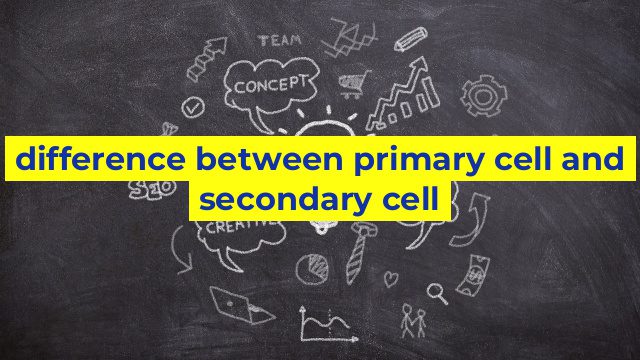Difference between Primary Cell and Secondary Cell
Introduction
In the world of energy storage, we hear two popular terms: primary cell and secondary cell. Both primary and secondary cells are common types of batteries, useful in a variety of applications. However, these two types of batteries differ in terms of their structure, usability, and other features. In this article, we will discuss the main differences between primary cell and secondary cell.
Primary Cells
Primary cells, also known as disposable batteries or one-time-use batteries, are commonly used in portable devices such as remote controls, flashlights, and toys. These batteries are designed to produce electrical energy through a chemical reaction that occurs in them when they’re used for the first time. Once the chemical reaction depletes, the battery’s life comes to an end, and the battery is considered “dead” and can’t be recharged.
Secondary Cells
Secondary cells, also known as rechargeable batteries, are designed to be charged and discharged repeatedly. These batteries store electrical energy in a chemical form that can be converted to electrical energy via an electrochemical reaction. When they are drained, a charger can restore their electrical capacity by sending an electrical current through the battery. Secondary cells are used in various high-power applications, such as automobiles, phones, and laptops.
Differences between Primary and Secondary Cells
The major differences between primary and secondary cells can be summarized in the following points:
1. Rechargeable: Secondary cells are designed to be rechargeable, while primary cells are not.
2. Lifespan: Primary cells have a limited lifespan, typically less time than secondary cells, after which they can’t produce power. In contrast, secondary cells can be recharged many times before their lifespan depletes.
3. Capacity: Secondary cells have a higher energy density than primary cells, meaning they can store more electrical energy per unit of weight or volume.
4. Environmentally Friendly: Secondary cells are more environmentally friendly than primary cells because they can be recharged and used multiple times, while primary cells contribute to more waste.
Conclusion
In summary, choosing between primary and secondary cells depends on the application, budget, and environmental concerns. While primary cells are useful for low-power applications and are relatively inexpensive, secondary cells offer more capacity and are more environmentally friendly. If you’re looking to purchase batteries for any application, it’s essential to consider the benefits and drawbacks of primary and secondary cells to determine which one better serves your needs.
Table difference between primary cell and secondary cell
| Primary Cell | Secondary Cell |
|---|---|
| Cannot be recharged | Can be recharged multiple times |
| Shorter lifespan | Longer lifespan |
| Lesser energy storage capacity | Higher energy storage capacity |
| Lower cost | Higher cost |
| Non-renewable source of energy | Renewable source of energy (in case of rechargeable batteries) |


